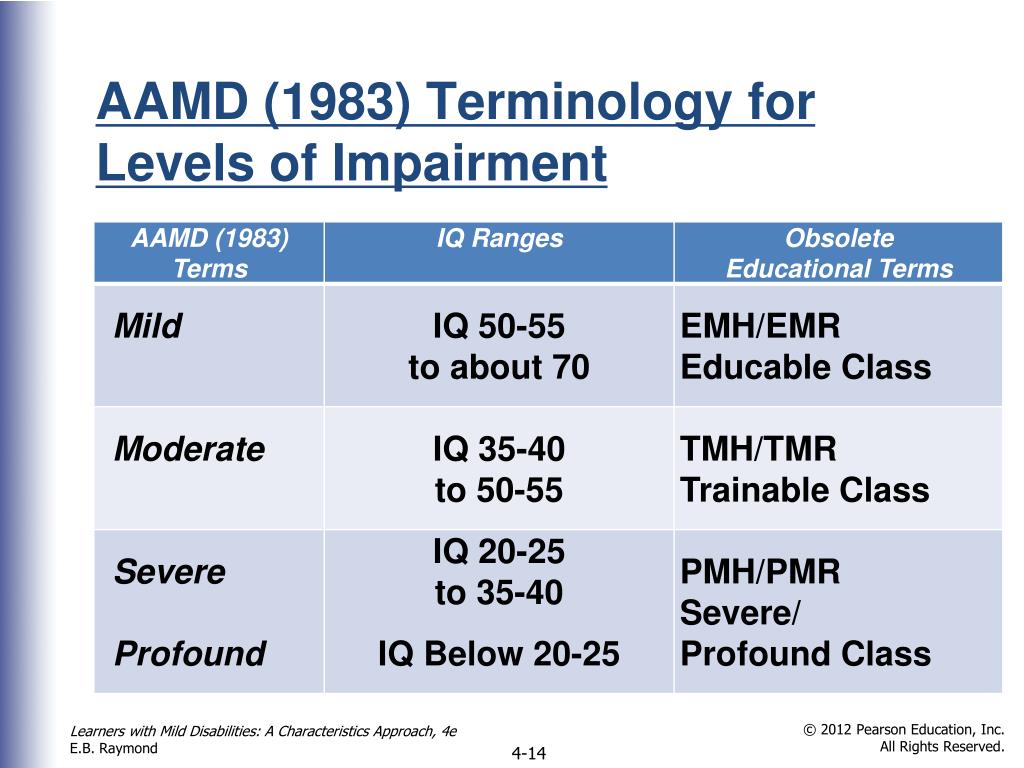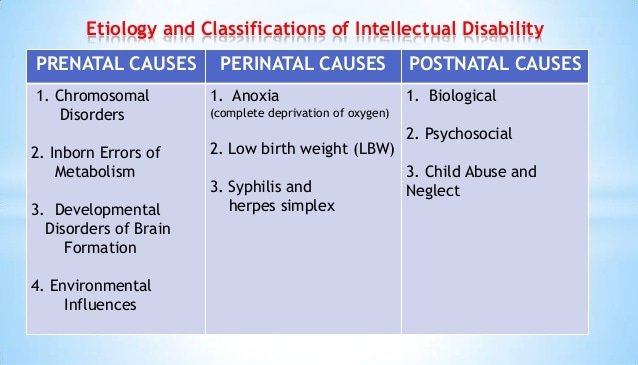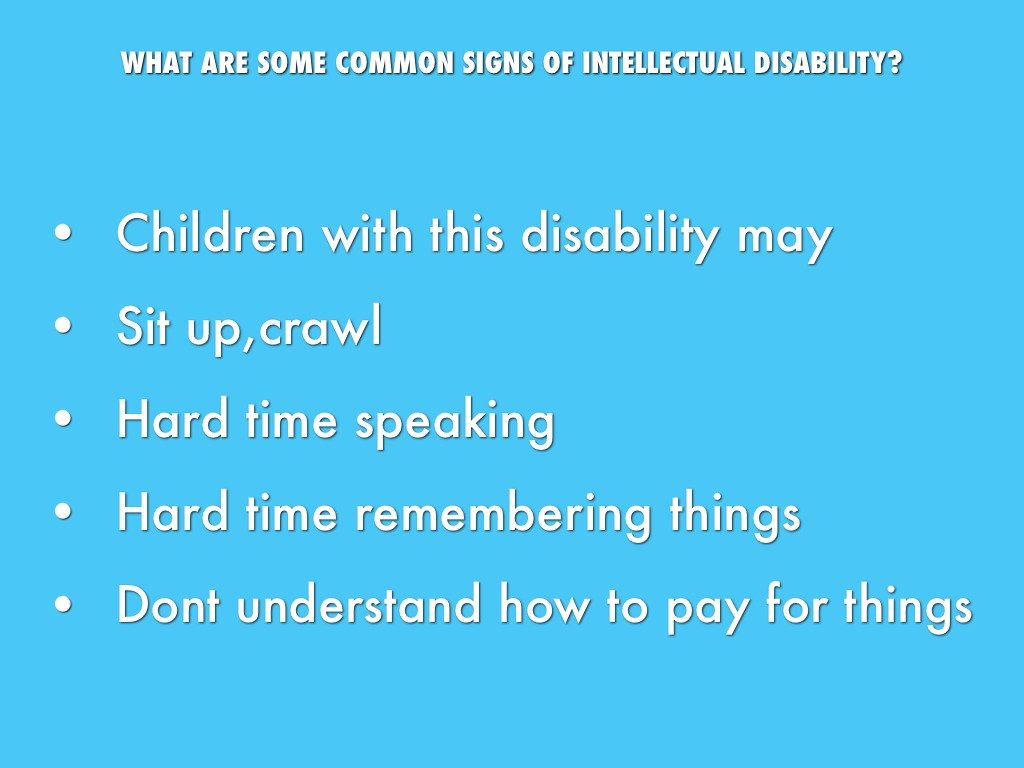Assessment Of Intellectual Function
Assessment of intellectual disability using standardized assessment tools is important as it is difficult to infer an individuals intellectual functioning based solely on conversation and observation. For example, confounding variables such as autism spectrum disorder may impact social and behavioral function making identification of intellectual disability difficult . The behaviors associated with autism could cause some people to infer low intellectual functioning, when in fact, individuals with autism might be identified through the use of standardized assessments of intelligence at much higher rate than previously considered .
Table 2
Based on the typical bell shaped curve of distribution of IQ scores, raising the IQ score from 70 to 75 as the upper limit of cut off, will double the number of individuals with intellectual disability from 2.27% to 4.85% of the population . An individual with an IQ score of 75 with significant adaptive disability will be considered to have intellectual disability, whereas an individual with no adaptive disability and an IQ score of 65 may not be considered to have intellectual disability .
Prognosis Of Intellectual Disability
A person with mild ID has a relatively normal life expectancy, and health care is improving long-term health outcomes for people with all types of intellectual disabilities. Many people with ID can support themselves, can live independently, and can be successfully employed with appropriate support.
Because intellectual disability sometimes coexists with serious physical problems, the life expectancy of people with ID may be shortened, depending on the specific condition. People with more severe intellectual disability are likely to require support for life. In general, the more severe the cognitive disability and the more physical problems the person has, the shorter the life expectancy.
Iiidefinition Of Mental Retardation
The definition of mental retardation has been modified several times throughout the years. For the sake of brevity, the numerous reconceptualizations and recapitulations of the definition of mental retardation are not discussed in full. Despite variability in definition, the definitions have held constant with the inclusion of impairments in cognitive and adaptive abilities. One of the major changes in definition occurred in the 1950s when a limitation in adaptive behavior was included as a necessary criterion for the diagnosis. Prior to this change, having a low IQ was sufficient for a diagnosis of mental retardation. Earlier definitions included varying levels of mental retardation, mostly based on the IQ score. For example, a person with an IQ ranging from 3540 to 5055 was considered moderately retarded.
In 1992, the American Association on Mental Retardation defined mental retardation as referring to substantial limitations in present functioning. It is characterized by significantly subaverage intellectual functioning, existing concurrently with related limitations in two or more of the following applicable adaptive skill areas: communication, self-care, home living, social skills, community use, self-direction, health and safety, functional academics, leisure, and work. An age limit criterion also was included in this definition.
Elliott H. Sherr, Donna M. Ferriero, in, 2003
Don’t Miss: How Much Does Disability Pay In California
What Happens To Students With Mild Intellectual Disability
MID also manifests as delays in social development. Students with this condition may be unable to perceive non-verbal cues in social situations, and may be viewed as emotionally immature by their peers. These students often exhibit obsessive-compulsive behaviors, and may need frequent reminders about appropriate social conduct.
What Is The Iq Of A Mild Intellectual Disability

mild intellectual disabilityintellectual
. Likewise, people ask, what is considered a mild intellectual disability?
A person is considered intellectually disabled if he or she has an IQ of less than 70 to 75. Of those affected, 85% have mild intellectual disability. This means they are just a little slower than average to learn new information or skills. With the right support, most will be able to live independently as adults.
One may also ask, what are the 4 levels of intellectual disability? TABLE 9-1Classifications of Intellectual Disability Severity
| Severity Category | Approximate Percent Distribution of Cases by Severity | DSM-IV Criteria |
|---|---|---|
| Mild | Approximate IQ range 5069 | |
| Moderate | Approximate IQ range 3649 | |
| Severe | Approximate IQ range 2035 | |
| Profound |
Accordingly, what is the IQ range of someone classified as having a mild intellectual disability?
Levels of Intellectual Disability
| IQ 19 or below |
What are examples of intellectual disabilities?
Intellectual Disability is the most common developmental disabilitynearly 6.5 million people in the United States have some level of ID.Examples of associated disabilities:
Read Also: How Much Is Disability In California
Child Vs Adult Presentation
Since one criteria is onset before 18 years of age, children are more likely to statistically have Mental Retardation. Children are at a higher risk for MR because most Mental Retardation comes from within the womb and birth, , but Mental Retardation can occur in other ways. Adults can also be diagnosed with Mental Retardation. Adult MR can also come about from toxic exposure and trauma . There are also unexplained reasons this particular reasoning is the largest one because there are so many cases of Mental Retardation that cannot be explained. .
Gender And Cultural Differences In Presentation
Individualized testing are always required to make the diagnosis of Mental Retardation. Mental Retardation due to known biological factors is similar among children of upper and lower socioeconomic classes, except that certain etiological factors are linked to lower socioeconomic status. Some biological factors are irregular genes or genes that did not fuse together properly, an example being down syndrome . In cases in which no specific biological causation can be identified, the Mental Retardation is usually milder and individuals from lower socioeconomic classes are overrepresented. There is no cultural differences in presentation of mental retardation. Mental Retardation is more common among males, with a male-to-female ratio of approximately 1.5:1.
Recommended Reading: How To Change Va Disability Direct Deposit
Levels Of Intellectual And Developmental Disabilities
|
The majority of persons with intellectual and developmental disabilities have a mild or moderate level ofintellectual developmental disability. They may be able to live and work independently or semi-independently in the community. Those with severe or profound levels of intellectual and developmental disability may be able to learn to care for themselves and function successfully in the community with varying levels of supervision. |
| For more information on the levels of intellectual and developmental disabilities, click on the sections of the chart below. |
| This content requires JavaScript enabled. |
How Does An Intellectual Disability Happen
Intellectual disabilityformerly known as mental retardationcan be caused by injury, disease, or a problem in the brain. For many children, the cause of their intellectual disability is unknown.
Some causes of intellectual disabilitysuch as Down syndrome, Fetal Alcohol Syndrome, Fragile X syndrome, birth defects, and infectionscan happen before birth. Some happen while a baby is being born or soon after birth.
Other causes of intellectual disability do not occur until a child is older these might include severe head injury, infections or stroke.
You May Like: How To Increase Your Va Disability Rating
Diagnostic Criteria For Intellectual Disabilities: Dsm
1. The American Psychiatric Association , which publishes the Diagnostic and Statistical Manual of Mental Disorders
2. The American Association on Intellectual and Developmental Disabilities .
Let’s review these two systems in greater detail.
The American Psychiatric Association diagnostic criteria for intellectual disability
The American Psychiatric Association’s diagnostic criteria for intellectual disability are found in the Diagnostic and Statistical Manual of Mental Disorders . A summary of the diagnostic criteria in DSM-5 are as follows:
1. Deficits in intellectual functioning
This includes various mental abilities:
- Reasoning
- Academic learning
- Experiential learning .
These mental abilities are measured by IQ tests. A score of approximately two standard deviations below average represents a significant cognitive deficit. These scores would occur about 2.5% of the population. Or stated differently, 97.5% of people of the same age and culture would score higher. The tests used to measure IQ must be standardized and culturally appropriate. This is typically an IQ score of 70 or below.
2. Deficits or impairments in adaptive functioning
Various skills are needed for daily living:
What Are The Levels Of Intellectual Disability
A diagnosis of intellectual disability mandates the person meet two criteria. The first criterion is a below-average score on an intelligence test. The second is ongoing limited functioning in daily living skills, which include dressing, self-care, communication, typical age level play or education. The term intellectual disability replaces the outdated term mental retardation but both terms remain in use. Intellectual disabilities are categorized into four different levels, which are based on the persons intelligence quotient score.
Profound Intellectual Disability
-
An IQ score below 20 or 25, along with limited daily functioning identify a profound intellectual disability. People with a diagnosis of a profound intellectual disability may live in group or family homes in the community with extensive supports. These supports may include housekeeping, personal care assistance and recreational support. Federal and state government mandate local school districts provide individualized educational supports for children ages 3 to 21. Educational supports for people with profound intellectual disabilities vary but may include adapted schoolwork, feeding and toileting assistance and occupational, speech and physical therapy.
Severe Intellectual Disability
Moderate Intellectual Disability
Mild Intellectual Disability
Recommended Reading: How To Increase Your Va Disability Rating
Environmental And Other Causes
Sometimes an intellectual disability is caused by an environmental factor or other causes. These causes can be quite varied but can include:
- Problems during pregnancy such as viral or bacterial infections
- Complications during birth
- Exposure to toxins such as lead or mercury
- Complications from illnesses such as meningitis, measles or whooping cough
- Malnutrition
- Exposure to alcohol and other drugs
- Trauma
Fetal Alcohol Spectrum Disorder

FASD refers to a number of conditions that are caused when an unborn foetus is exposed to alcohol.
When a mother is pregnant, alcohol crosses the placenta from the mothers bloodstream into the babys, exposing the baby to similar concentrations as the mother .
The symptoms can vary however can include distinctive facial features, deformities of joints, damage to organs such as the heart and kidneys, slow physical growth, learning difficulties, poor memory and judgement, behavioural problems, and poor social skills.
Many cases are also often misdiagnosed as autism or ADHD as they can have similarities.
The World Health Organisation recommends that mothers-to-be, or those planning on conceiving, should completely abstain from alcohol.
Also Check: How Much Does A Va Disability Lawyer Cost
What To Do With A Student With Mild Mental Retardation
Be careful, though. Dont talk down to the student, as this may exacerbate feelings of inferiority and issues with self-esteem. Keep conversations as normal as possible, always attempting to be as inclusive as you can. Establishing simple, clear rules for the classroomas well as consequences for when theyre brokenis crucial.
Human Rights And Legal Status
The law treats person with intellectual disabilities differently than those without intellectual disabilities. Their human rights and freedoms, including the right to vote, the right to conduct business, enter into a contract, enter into marriage, right to education, are often limited. The courts have upheld some of these limitations and found discrimination in others. The UN Convention on the Rights of Persons with Disabilities, which sets minimum standards for the rights of persons with disabilities, has been ratified by more than 180 countries. In several U.S. states, and several European Union states, persons with intellectual disabilities are disenfranchised. The European Court of Human Rights ruled in Alajos Kiss v. Hungary that Hungary violated the applicant’s rights by a blank disenfranchisement of persons with intellectual disabilities who did not hold legal capacity.
Recommended Reading: How Much Does Disability Pay In California
What Are The Most Common Causes
The most common causes of intellectual disabilities are:
Genetic conditions. Sometimes an intellectual disability is caused by abnormal genes inherited from parents, errors when genes combine, or other reasons. Examples of genetic conditions are Down syndrome, Fragile X syndrome, and phenylketonuria .
Complications during pregnancy. An intellectual disability can result when the baby does not develop inside the mother properly. For example, there may be a problem with the way the babys cells divide. A woman who drinks alcohol or gets an infection like rubella during pregnancy may also have a baby with an intellectual disability.
Problems during birth. If there are complications during labor and birth, such as a baby not getting enough oxygen, he or she may have an intellectual disability.
Diseases or toxic exposure. Diseases like whooping cough, the measles, or meningitis can cause intellectual disabilities. They can also be caused by extreme malnutrition, not getting appropriate medical care, or by being exposed to poisons like lead or mercury.
We know that intellectual disability is not contagious: you cant catch an intellectual disability from anyone else. We also know its not a type of mental illness, like depression. There are no cures for intellectual disability. However, children with intellectual disabilities can learn to do many things. They may just need take more time or learn differently than other children.
What Services Are Available For People With Intellectual Disability
For babies and toddlers, early intervention programs are available. A team of professionals works with parents to write an Individualized Family Service Plan, or IFSP. This document outlines the childs specific needs and what services will help the child thrive. Early intervention may include speech therapy, occupational therapy, physical therapy, family counseling, training with special assistive devices, or nutrition services.
School-age children with intellectual disabilities are eligible for special education for free through the public school system. This is mandated by the Individuals With Disabilities Education Act . Parents and educators work together to create an Individualized Education Program, or IEP, which outlines the childs needs and the services the child will receive at school. The point of special education is to make adaptations, accommodations, and modifications that allow a child with an intellectual disability to succeed in the classroom.
You May Like: How Much Is The Average Disability Check
How Do I Know If My Child Has Intellectual Disability
How Do I Know If My Child Has an Intellectual Disability?
Identification And Evaluation Of Mental Retardation
DONNA K. DAILY, M.D., HOLLY H. ARDINGER, M.D., and GRACE E. HOLMES, M.D., University of Kansas Medical Center, Kansas City, Kansas
Am Fam Physician. 2000 Feb 15 61:1059-1067.
See related patient information handout on mental retardation, written by the authors of this article.
Mental retardation in young children is often missed by clinicians. The condition is present in 2 to 3 percent of the population, either as an isolated finding or as part of a syndrome or broader disorder. Causes of mental retardation are numerous and include genetic and environmental factors. In at least 30 to 50 percent of cases, physicians are unable to determine etiology despite thorough evaluation. Diagnosis is highly dependent on a comprehensive personal and family medical history, a complete physical examination and a careful developmental assessment of the child. These will guide appropriate evaluations and referrals to provide genetic counseling, resources for the family and early intervention programs for the child. The family physician is encouraged to continue regular follow-up visits with the child to facilitate a smooth transition to adolescence and young adulthood.
Read Also: How To Calculate Disability Retirement Pay
Assessment Of Adaptive Function
The Vineland Adaptive Behavior scales are commonly used to measure adaptive functioning of individuals with intellectual disability . Three versions of the Vineland-3 are available, as listed in Table 3, offering an interview form, parent/caregiver form, and teacher form. The Vineland 3 assesses adaptive functioning in communication, daily living skills, socialization, motor skills , and maladaptive behavior . Although, in most cases, there is a correlation between the level of cognitive functioning and adaptive functioning this can vary depending up on multiple factors.
Table 3
AAIDDs Diagnostic Adaptive Behavior Scale is under development. The DABS provides a comprehensive standardized assessment of adaptive behavior. Designed for use with individuals from 4 to 21 years old, DABS provides precise diagnostic information around the cutoff point where an individual is deemed to have significant limitations in adaptive behavior. The presence of such limitations is one of the measures of intellectual disability .
Genetic and metabolic testing
Neuroimaging studies
How To Reduce The Chance Of Intellectual Disability

Prevention should begin even before pregnancy, with adequate prenatal care, including folic acid intake and appropriate vaccination. Pregnant women need to avoid malnutrition, alcohol and tobacco consumption, and exposure to toxic environmental agents.
Similarly, proper medical care during labor helps reduce the risk of complications. After birth, the baby should be properly cared for, meaning that their physical and emotional needs should be met. But you should know that it isnt possible to eliminate the risk.
Also Check: How Much Does Permanent Disability Pay In California
Treatment Of Intellectual Disability
-
Multidisciplinary support
A child with ID is best cared for by a multidisciplinary team consisting of the following:
-
Primary care doctor
-
Teachers
-
Orthopedists
Other professionals may also be part of the team if necessary. Together with the family, these people develop a comprehensive, individualized program for the child that is begun as soon as the diagnosis of ID is suspected. The parents and siblings of the child also need emotional support and sometimes counseling. The whole family should be an integral part of the program.
The full array of a person’s strengths and weaknesses must be considered in determining what kind of support is needed. Factors such as physical disabilities, personality problems, mental illness, and interpersonal skills are all taken into consideration. People with ID and coexisting mental health disorders such as depression may be given appropriate drugs in dosages similar to those given to those without ID. However, giving a child drugs without doing behavioral therapy and making environmental changes is usually not helpful.
